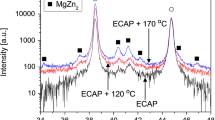Abstract
Incited by the aim of improving the strength and preserving a moderate ductility, the promising approach of a combined equal-channel angular pressing (ECAP) and aging treatment was applied to the 6056 Al–Mg–Si–(Cu) alloy. This method has been proven to be most effective for a small number of ECAP passes in the solid-solution condition and a following aging treatment, which is timed to enable precipitation hardening up to the peak strength on the one hand and microstructural recovery just before the onset of softening on the other hand. In this work, the evolution of hardness during post-ECAP aging and the effect of aging temperature and time on strength and ductility will be discussed. By means of low-voltage scanning transmission electron microscopy, the underlying microstructural features in terms of dislocation structure and precipitation characteristics will be presented. It has been found that peak aging especially at low-aging temperatures is suitable for achieving the desired high-strength combination, whereas—on the expense of some percent in the strengthening—the ductility is best in slightly underaged conditions. Compared to the initial peak-aged condition, an increase in strength of 27%, combined with a moderate ductility of 6.5% uniform elongation was achieved for peak aging at 150 °C after two passes of ECAP.








Similar content being viewed by others
References
Valiev RZ, Langdon TG (2006) Prog Mater Sci 51:881–981
Furukawa M, Horita Z, Langdon TG (2001) Adv Eng Mater 3:121–125
Valiev RZ (2005) In: Zehetbauer M, Valiev RZ (eds) Nanomaterials by severe plastic deformation. Wiley-VCH Verlag GmbH & Co. KGaA, pp 107–117
Mughrabi H, Höppel HW, Kautz M (2004) Scr Mater 51:807
Höppel HW (2006) Mater Sci Forum 503–504:259
Koch CC (2003) Scr Mater 49:657
Höppel HW, Kautz M, Xu C, Murashkin A, Langdon TG, Valiev RZ, Mughrabi H (2006) Int J Fatigue 28:1001
Kim JK, Jeong HG, Hong SI, Kim YS, Kim WJ (2001) Scr Mater 45:901
Kim WJ, Chung CS, Ma DS, Hong SI, Kim HK (2003) Scr Mater 49:333
Kim WJ, Kim JK, Kim HK, Park JW, Jeong YH (2008) J Alloys Compd 450:222
Zhao YH, Liao XZ, Cheng S, Ma E, Zhu YT (2006) Adv Mater 18:2280
Cheng S, Zhao YH, Zhu YT, Ma E (2007) Acta Mater 55:5822
Hockauf M, Meyer LW, Zillmann B, Hietschold M, Schulze S, Krüger L (2009) Mater Sci Eng A 503:167
Barber RE, Dudo T, Yasskin PB, Hartwig KT (2004) Scr Mater 51:373
Roven HJ, Liu M, Werenskiold JC (2008) Mater Sci Eng A 483–484:54
Cai M, Field DP, Lorimer GW (2004) Mater Sci Eng A 373:65
Zhao YH, Liao XZ, Jin Z, Valiev RZ, Zhu YT (2004) Acta Mater 52:4589
Takeda M, Ohkubo F, Shirai T, Fukui K (1998) J Mater Sci 33:2385. doi:10.1023/A:1004355824857
Gallais C, Denquin A, Bréchet Y, Lapasset G (2008) Mater Sci Eng A 496:77
Miao WF, Laughlin DE (2000) Metall Mater Trans A 31:361
Chakrabarti DJ, Laughlin DE (2004) Prog Mater Sci 49:389–410
Delmas F, Casanove MJ, Lours P, Couret A, Coujou A (2004) Mater Sci Eng A 373:80
Cabibbo M, McQueen HJ, Evangelista E, Spigarelli S, Di Paola M, Falchero A (2007) Mater Sci Eng A 460–461:86
Ismail ZH (1995) Scripta Metall Mater 32:457
Acknowledgements
The authors thank Mr. D. Schmidt and Mr. M. Bormann for their assistance in heat treatment and mechanical testing and Mrs. A. Schulze for the accurate specimen preparation for STEM measurements. This work was financially supported by the “Deutsche Forschungsgemeinschaft” within the framework of “Sonderforschungsbereich 692—Hochfeste aluminiumbasierte Leichtbauwerkstoffe für Sicherheitsbauteile”. Further thanks go to RIBE Fastening Systems in Germany for kindly providing the 6056 Al alloy.
Author information
Authors and Affiliations
Corresponding author
Rights and permissions
About this article
Cite this article
Hockauf, K., Meyer, L.W., Hockauf, M. et al. Improvement of strength and ductility for a 6056 aluminum alloy achieved by a combination of equal-channel angular pressing and aging treatment. J Mater Sci 45, 4754–4760 (2010). https://doi.org/10.1007/s10853-010-4544-y
Received:
Accepted:
Published:
Issue Date:
DOI: https://doi.org/10.1007/s10853-010-4544-y



